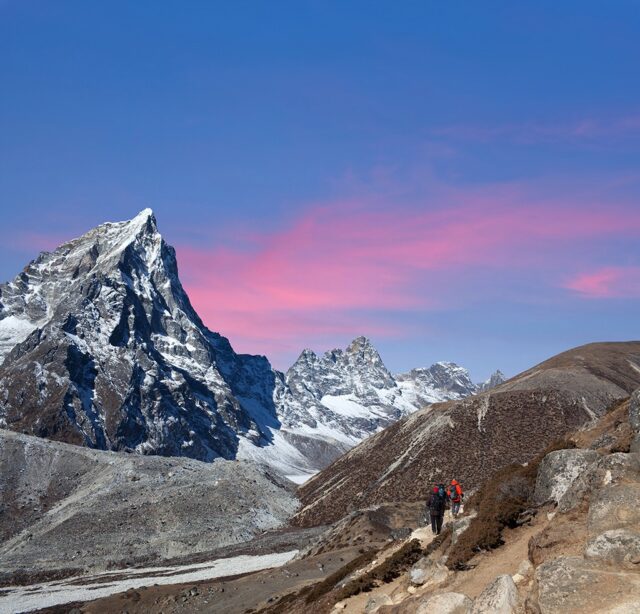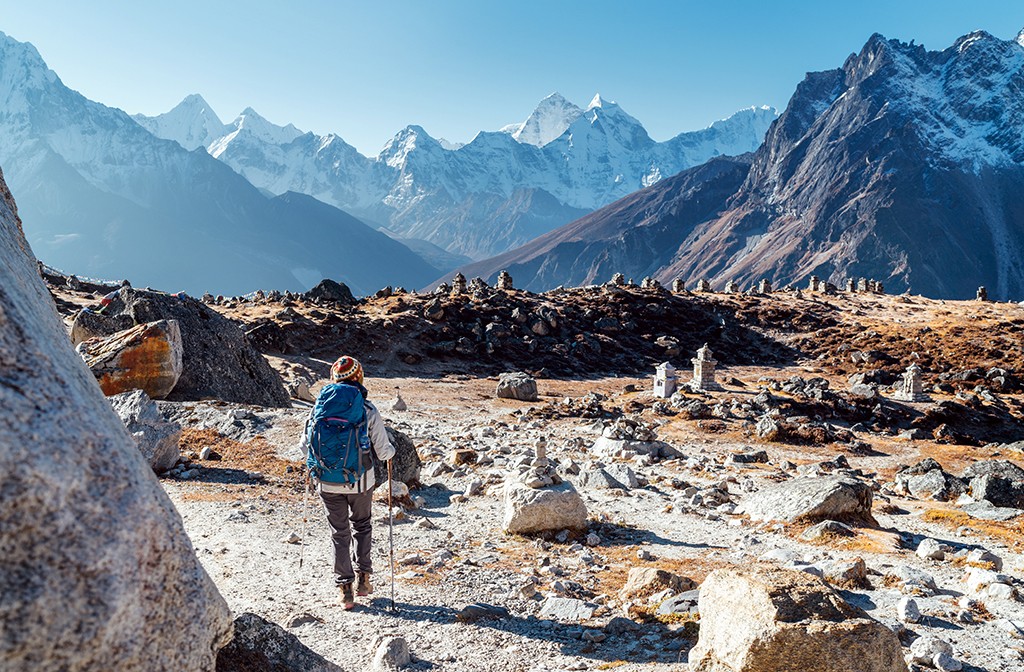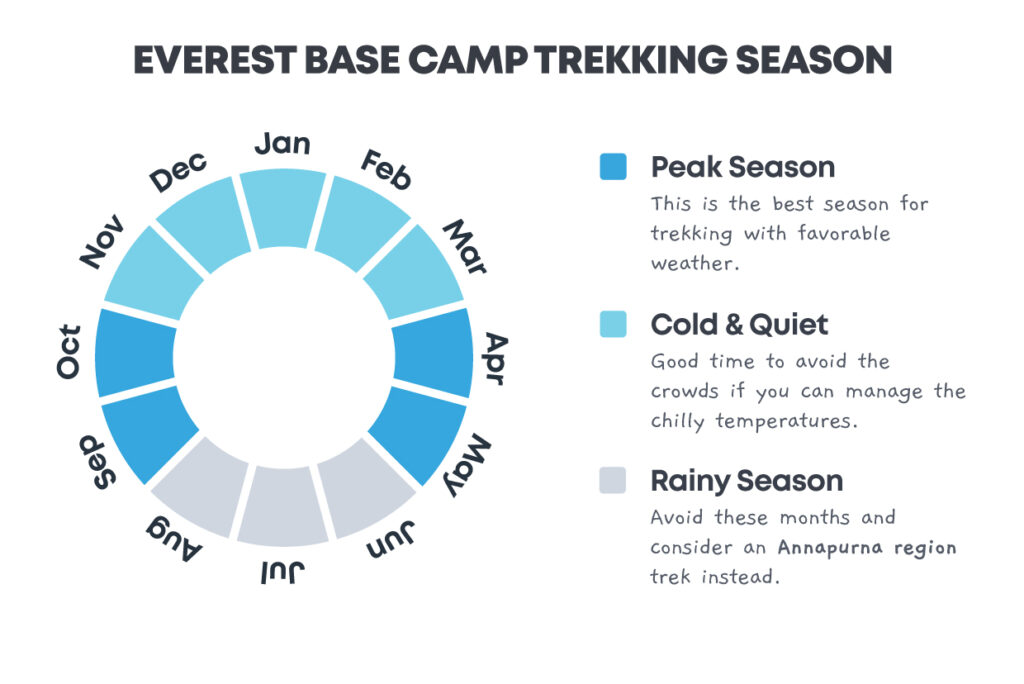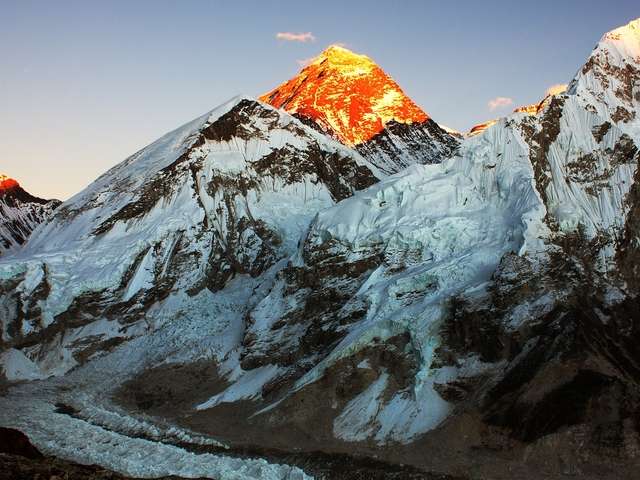
The Everest Base Camp trek is a mecca for adventurous, nature loving souls and hard core granolas alike. It offers pristine vistas for aspiring landscape photographers to capture and is a formidable challenge beckoning to trekkers the world over. If you’re reading this, you’re likely already caught in the allure of Nepal’s most impressive trekking region and are ready to have the question of “When’s the best time to go?” answered. The short answer: The most popular months to go are April, May and October. February, March, November and December are also great months to trek Everest Base Camp. However, the complete answer is more nuanced. Would you like to go with cooler weather and less crowds? Or warmer weather and see the tent city of Everest Base Camp in full swing? Read our comprehensive guide to decide which month is best for you! Please don’t hesitate to reach out if you’d prefer an adventure consultant to help you plan a trek curated especially for your schedule.
January Treks
January is the end of the “Winter Trekking Season” in Nepal. Although the temperatures are very cold, the low number of visitors and empty trails can make this an enjoyable time of year to trek. If you bring a lot of layers and are prepared to tolerate the cold, the brisk weather will offer stunning, clear mountain views. The generally cloudless sky also means issues with flights are uncommon during this time of year. As always with the Himalayas, weather delays from snow are possible but not likely.
February Treks
This month is when the weather is finally starting to warm up and there are few more visitors coming to enjoy the generally nice weather. Though it is admittedly a little more chilly than warm, it can be great conditions for trekking. The mostly empty trails give trekkers the opportunity to take in unrivaled views in relative solitude. With similarly clear skies to the month before there are only a few flight issues. Additionally, the clarity of the mountains bring unparalleled views, making this the month often hailed as the best by photographers.
March Treks
Spring is the true start of the trekking season for Everest Base Camp and by mid-month the trail starts to get crowded. Longer days with little to no rain make for continuous panoramic views of himalayas throughout your trek. The warm weather also brings a lush green vibrance to the region as the trees and foliage come back to life. With the beautiful conditions and scenery visitors often wonder why March isn’t a more popular month for trekking to Everest Base Camp.
April Treks
April is the peak of the “Summer Trekking Season” and its favorable weather makes it one of the most popular months to go. The warmer weather ushers in the blooming of pink, red and white Rhododendrons throughout the park. It’s recommended that trekkers book in advance if they’d like to trek to Everest Base Camp this month as the tent city is bustling with activity and lodging en route will likely be at capacity. The visibility and temperatures are great this month, although there is a slight possibility of heat haze.
May Treks
Early May is when Everest Base Camp is at its warmest and so it’s a very busy time to go. The trails are brimming with porters, trail animals, and additional support crews as climbers attempt to summit around May 10th as its the best weather of the year. However, the warmer weather can also start to bring clouds that can obscure views.
This is especially true towards the end of May if the monsoon starts early. The end of the month can bring more flight delays and the dissipation of the trekking crowds.
Early June Treks
Early June brings evening rains and more verdant foliage. The trekking can be good but it really depends on monsoon rains and good planning. Even with decent weather forecasts be prepared for flight delays.

Monsoon Treks
Mid June, July, and Early August are the monsoon season. We don’t normally arrange treks in the Everest Region as heavy rains can delay flights to Lukla for up to a week and the trekking is difficult. The stormy skies obscure views of the Himalayas and serve as a reminder that a thunderstorm could hit at any second. If you are looking to trek in Nepal during this summer season, it’s best to trek in the monsoon’s rain shadow. The Annapurna Circuit, for example, is still a great option at this time of year.
Late August Treks
End of August brings the end of monsoon and the beginning of the autumn trekking season. At the end of August there will be few crowds on the trails as the trekking season starts. There are often rain showers but there are also contrasting windows of good visibility. After the long rain season, the valleys will be green and refreshing to trek through. At this time of year it is wise to give yourself extra days in your schedule to accommodate for flight delays.
September Treks
September is generally a good month for trekking, as is the rest of Autumn in the Himalayas for that matter. September is characterized by peaceful conditions, free from crowds and is also considered by some to have better views of the mountains than the summer trekking season. Rains are more likely earlier in the month but can continue into early October depending on the weather pattern. This is another month where trekkers need to be prepared for flight delays, especially earlier in the month.

October Treks
This is the busiest month for trekking. The monsoon can extend into the first part of the month but once it ends the weather is very stable. It is colder than the other most popular trekking month of April but the visibility is better after the monsoon clears. With no mud on the trails, the dry, mild weather allows trekkers to focus solely on the breathtakingly crisp, panoramic views. Due to its popularity, it’s wise to book in advance for October.
November Treks
This is one of the best months of the year for trekking as there’s good weather with virtually no rain or flight delays. In addition to the fair weather, it’s less crowded offering unimpeded, splendid views along the trek. The skies are cloudless and visibility is crystal clear. It is cooler than October, however it’s the last month to go with moderate autumn weather and before winter sets in. For reference, it is around -15°C by day and much colder at night.
December Treks
December is still a good time to trek Everest Base Camp. The weather is stable with few rain showers or flight delays but it can be very cold at night at the higher elevations. There are minimal crowds this time of year and although snow is possible it is not common. Sunny skies during the day make for dramatic mountain photography opportunities. However, it also means a stark contrast between the daytime and nighttime temperatures which dip well below zero. Be prepared for windchill all month and especially as the weather gets increasingly colder towards the end of the year.
Other Treks in the Everest Region
While this post has focused on the trek to Base Camp the conditions are generally similar for the other treks in the Everest region as well as the trekking peaks. Some of the treks that involve high passes and the trekking peaks are not possible in the winter due to snowfall on the passes. Here is a look at the months that it is possible to do each of the treks in the region. Gokyo can still be reached in Dec/Jan but normally we reroute the trek and skip Cho La pass.

We hope you found this month by month guide of Everest Base Camp helpful in scheduling your trek! The adventure consultants here at Adventurehero always look forward to helping guests plan their trips. Please like, comment, and subscribe to our mailing list to let us know how we’re doing.

















